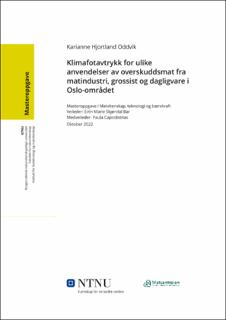| dc.contributor.advisor | Bar, Eirin Marie Skjøndal | |
| dc.contributor.advisor | Capodistrias, Paula | |
| dc.contributor.author | Oddvik, Karianne Hjortland | |
| dc.date.accessioned | 2023-04-18T17:20:00Z | |
| dc.date.available | 2023-04-18T17:20:00Z | |
| dc.date.issued | 2022 | |
| dc.identifier | no.ntnu:inspera:124326979:68117502 | |
| dc.identifier.uri | https://hdl.handle.net/11250/3063668 | |
| dc.description.abstract | Matsvinn er et globalt problem med både økonomiske, miljømessige og sosiale utfordringer. Omtrent en tredjedel av all mat som produseres blir kastet. Ved at mat kastes vil blant annet økonomiske utgifter, klimagassutslipp og arbeidskraft knyttet til produksjonen være bortkastet. Samtidig går millioner av mennesker sultne og den globale etterspørselen etter mat øker. Dette gjør matsvinn til et viktig og komplekst problem. Svinnet oppstår gjennom hele matverdikjeden, fra produksjons- til forbrukerleddet, og fører til store unødvendige klimagassutslipp. I 2020 ble det kastet minst 400 000 tonn spiselig mat i Norge, med et klimafotavtrykk på 1,3 millioner tonn CO2-ekvivalenter (CO2-ekv).
Spiselig overskuddsmat som av ulike grunner ikke blir solgt til fullpris blir enten kastet og håndtert som avfall, eller «reddet» fra dette ved at den selges til redusert pris eller doneres. Oppgaven undersøker klimafotavtrykket for ulike anvendelser av overskuddsmat fra matindustri, grossist og dagligvare i Oslo-området. Det beregnes besparelsen i klimagassutslipp (målt i CO2-ekv) dersom maten reddes og doneres til Matsentralen Oslo (MSO) sammenlignet med om maten kastes og benyttes til biogassproduksjon, til forbrenning med energiutnyttelse eller som dyrefôr. Oppgaven er skrevet i samarbeid med Matsentralen Norge, som jobber for å redde mat som ville blitt matsvinn og redistribuere den til vanskeligstilte mennesker via veldedige organisasjoner. På denne måten støttes sosiale bærekraftaspekter ved å sikre mat til vanskeligstilte, og miljømessige aspekter ved å redusere mengden unødvendige klimagassutslipp knyttet til spiselig mat som kastes.
Tidligere studier har sammenlignet ulike slutthåndteringsmetoder for matsvinn, og noen har også vurdert dette opp mot donasjon av overskuddsmat. Det finnes imidlertid ingen studier som vurderer miljøfordelene i et norsk perspektiv ved å donere mat fremfor å bruke den til dyrefôr, biogassproduksjon eller forbrenning. Å undersøke klimafotavtrykket til ulike slutthåndteringsmetoder for overskuddsmat gir et begrenset perspektiv, men er likevel viktig for å vurdere hvilke alternativer i avfallshierarkiet som er mest klimagunstig.
Donasjon av overskuddsmat er alternativet som medvirker til størst utslippsreduksjon av de fire vurderte slutthåndteringsmetodene. Videre medfører utnyttelse av matsvinn til dyrefôr større utslippsreduksjon enn om matsvinnet sendes til biogassproduksjon. Det minst gunstige alternativet, sett i et utslippsperspektiv, er bruk av matsvinn til forbrenning med energiutnyttelse. Oppgavens resultat støtter opp om prioriteringene i avfallspyramiden og Matvetts ressurspyramide, som setter donasjon av mat høyere enn utnyttelse til dyrefôr, biogassproduksjon og forbrenning. | |
| dc.description.abstract | Food waste is a global problem with both economic, environmental and social challenges. About a third of all produced food is thrown away. Financial expenses, greenhouse gas (GHG) emissions and labor related to the production of the food that is wasted will thus be worthless. At the same time, millions of people are starving and the global demand for food is increasing. This makes food waste an important and complex problem. Food waste occurs throughout the food value chain, from production to consumption, and leads to large unnecessary GHG emissions. In 2020, 400,000 tonnes of edible food was thrown away in Norway, with a climate footprint of 1.3 million tonnes of CO2 equivalents (CO2 eq).
Edible surplus food that for various reasons is not sold at full price is either thrown away and handled as waste, or "rescued" from this by being sold at a discounted price or donated to disadvantaged people. This thesis examines the saving in GHG emissions (measured in CO2 eq) for food that is rescued and donated to the food bank Matsentralen Oslo (MSO) compared to food waste that is used for biogas production, for incineration with energy utilization, or as animal feed. The climate footprint of the various alternatives has been assessed based on available disposal methods in the Oslo area. The thesis is written in collaboration with Food Banks Norway (Matsentralen Norge), an organization which redistributes surplus food from food producers, wholesalers and groceries to charities that help disadvantaged people in Norway. In this way, social sustainability aspects are maintained by securing food for people in need, as well as environmental aspects by reducing unnecessary GHG emissions.
Previous studies have compared different handling methods for food waste, and some have also compared this with donating surplus food. However, there are no studies that assess the environmental benefit from a Norwegian perspective by donating food rather than using it as animal feed, for biogas production or for incineration. Examining the climate footprint of different disposal methods for surplus food gives a limited perspective, but is nevertheless important for assessing which alternatives in the waste hierarchy are the most climate-friendly.
Donation of surplus food is the alternative that contributes to the greatest reduction of GHG emission among the four methods assessed. Furthermore, utilization of food waste for animal feed provides a greater GHG emission reduction than if the food waste is used for biogas production. The least favorable alternative in relation to GHG emissions is the use of food waste for incineration with energy recovery. The results support the priorities in the waste pyramid and Matvett's Resource Pyramid, which prioritize the donation of surplus food higher than utilization for animal feed, biogas production and incineration. | |
| dc.language | nob | |
| dc.publisher | NTNU | |
| dc.title | Klimafotavtrykk for ulike anvendelser av overskuddsmat fra matindustri, grossist og dagligvare i Oslo-området | |
| dc.type | Master thesis | |
